Washington, D.C. — More than 1.57 million Americans live without a toilet or tap at home, costing the U.S. economy $8.58 billion every year, according to a report produced by DigDeep with contributions from partners including the International Association of Plumbing and Mechanical Officials (IAPMO®). Titled “Draining: The Economic Impact of America’s Hidden Water Crisis,” Read more
IAPMO
Washington, D.C. — More than 1.57 million Americans live without a toilet or tap at home, costing the U.S. economy $8.58 billion every year, according to a report produced by DigDeep with contributions from partners including the International Association of Plumbing and Mechanical Officials (IAPMO®).
Titled “Draining: The Economic Impact of America’s Hidden Water Crisis,” the report provides an in-depth analysis of the costs and benefits of extending water and sanitation access to every home in the United States. The $8.58 billion annual figure averages out to $15,800 per household in health care, time spent collecting and paying for bottled water, loss of time at work and school, and premature death. The full report is available online at digdeep.org/draining.
Produced by DigDeep, a nonprofit organization working to improve access to clean running water in U.S. communities, the report includes contributions from partners including Altarum, the American Heart Association, Robert Wood Johnson Foundation, and IAPMO. It builds on and reinforces key recommendations from DigDeep’s earlier report on the topic: “Closing the Water Access Gap in the United States: A National Action Plan.”
The report attributes the following statistics to the water access gap:
- $15,800 — the annual cost, per household, to the U.S. economy for each household without access to running water or basic plumbing. It includes health care costs, time spent collecting and paying for bottled water, loss of time at work or school, and premature death.
- 219,000 — the annual number of waterborne illnesses, including Legionella.
- 71,000 — the annual number of cases of mental illness
- 68.7 million — the annual number of work hours lost
- $1 billion — the annual loss in U.S. Gross Domestic Product (GDP)
- 610 — annual premature deaths
- $8.58 billion — total annual cost to the U.S. economy
“While speaking to communities for our 2019 report, we heard devastating stories about impacts to people’s health, employment, leisure time, and general well-being,” DigDeep Founder and CEO George McGraw said. “Now we are finally able to measure the true magnitude of those impacts in real dollars. We must close the water access gap. As this report shows, we can’t afford not to.”
While the water access gap is wide and deep, it is solvable — to the benefit of numerous parties even beyond the individuals and families suffering from a lack of access to water and sanitation. With the passage of the bipartisan Infrastructure Investment and Jobs Acts of 2021, $55 billion in water-specific infrastructure funding is available to be spent over the next five years.
Since much of that investment will be used to upgrade and repair existing systems, DigDeep notes that targeted investments are needed for new access and to close the water gap for good.
The report’s authors suggest the following action steps to solve the problem:
- Expand and refocus federal and state funding. Closing the water access gap requires more funding, more flexibility in funding, and funding for interim solutions and new technologies. These efforts should build on the $55 billion in water-specific funding authorized in the Infrastructure Investment and Jobs Acts of 2021.
- Use data to bring visibility to communities. Currently, no central entity collects data on the scope of the U.S. water access gap. Federal data collection must be accompanied by outreach to vulnerable communities to assist them in using data for advocacy and designing solutions.
- Define the water access gap as a crisis. Many countries, and the United Nations, have recognized the urgency of water access by passing resolutions recognizing the human right to water and sanitation. The U.S. federal government should signal its leadership on this issue by doing the same.
- Build a domestic Water, Sanitation, and Hygiene (WaSH) sector. Closing the water access gap will only be possible if led by a dedicated “community of practice” made up of NGOs, funders, research institutions, government agencies, and impacted communities working together toward a shared goal.
“As a technical adviser for this report, IAPMO was pleased to work with the broad coalition of organizations that contributed to this research, and we wholeheartedly endorse these recommendations,” IAPMO Executive Vice President of Government Relations Dain Hansen said. “Access to clean water and safe sanitation is a basic right, and closing the water access gap means advancing equity and righting historical wrongs. IAPMO is proud to be a strong advocate for every community to be able to access the financial and technical resources required to close this water and sanitation access gap.”

San Antonio — The seventh Emerging Water Technology Symposium returned as an in-person event for the first time in four years, bringing together industry, manufacturing, water utility and government leaders from around the world. A focus of this year’s event was on resources communities require to build safe and resilient plumbing systems as well as Read more
San Antonio — The seventh Emerging Water Technology Symposium returned as an in-person event for the first time in four years, bringing together industry, manufacturing, water utility and government leaders from around the world. A focus of this year’s event was on resources communities require to build safe and resilient plumbing systems as well as meet the growing list of challenges to America’s drinking water.
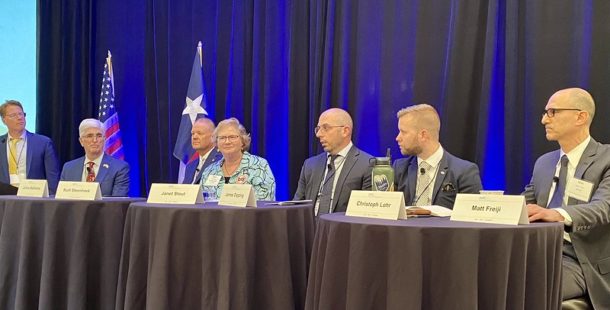
The esteemed panel on Effective Risk Management of Building Water Systems for Pathogen Control included (from l to r) Julius Ballanco, president, JB Engineering; Kurt Steenhoek, International Representative, UA; Janet Stout, Executive VP and Founder, Special Pathogen Laboratory; James Dipping, Director of Plumbing Engineering, Environmental Systems Design, Inc.; Christoph Lohr, VP of Strategic Initiatives, IAPMO; and Matt Freije, CEO, HC Info.
The May 10-11 event at the Westin Riverwalk, San Antonio was co-convened by the Alliance for Water Efficiency (AWE), the American Society of Plumbing Engineers (ASPE), the International Association of Plumbing and Mechanical Officials (IAPMO) and Plumbing Manufacturers International (PMI).
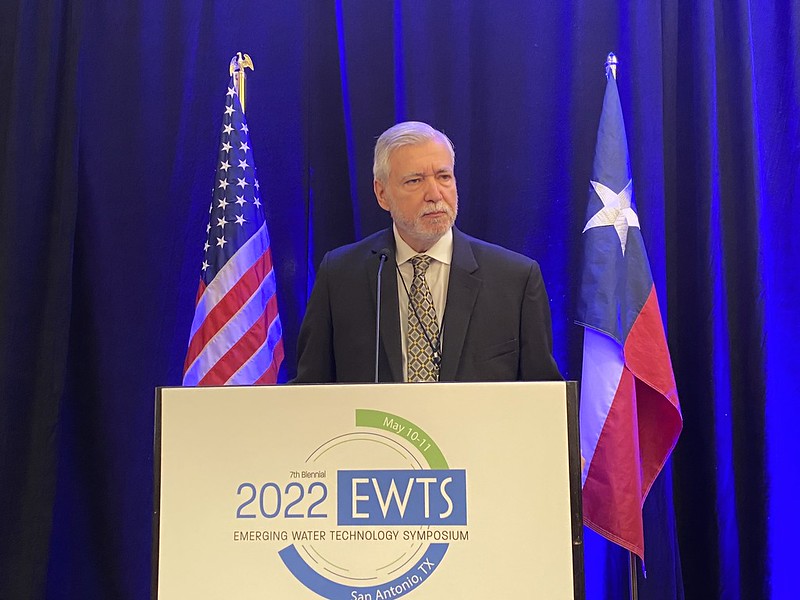
Pete DeMarco
“As an industry we have a number of high priority research needs that relate to water quality as well as water and energy efficiency,” IAPMO Executive Vice President of Advocacy and Research Pete DeMarco explained in discussing the importance of the symposium. “This year’s event brought together some of the brightest minds industry has to offer all focused on how we make our plumbing and mechanical systems safer and more resilient to meet the challenges ahead.”
In his opening remarks, DeMarco pointed to a number of accomplishments for which the EWTS has served as a springboard, including the development of the Green Plumbing and Mechanical Code Supplement (now the Water Efficiency and Sanitation Standard WE•Stand); ANSI/ASHRAE Standard 188-2018, Legionellosis: Risk Management for Building Water Systems; ASSE 12000 series on infection control and water quality, which is in IAPMO’s Uniform Plumbing Code (UPC®); and IAPMO’s Water Demand Calculator, whose second version was released in 2020.
“This symposium provides a much-needed platform for stakeholders across the industry to gather, discuss the latest research, and then discuss how we can take action,” he said. “It is a highly valuable event, and I look forward to seeing it continue to grow in the future.”
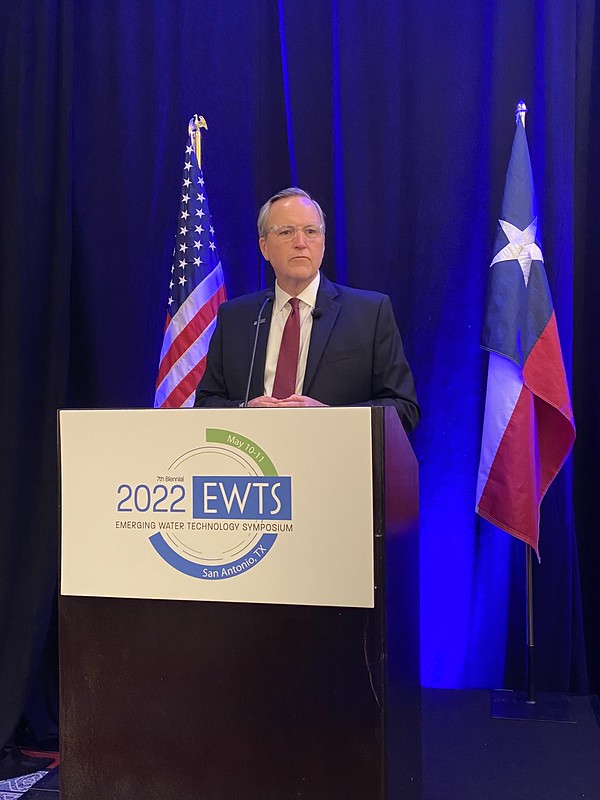
Kerry Stackpole
PMI CEO Kerry Stackpole spoke at the event and said the relationships between the organizations represented at EWTS had likely never been more important than they are now. He said that while the best and brightest among us devised medical solutions to the COVID-19 pandemic, the plumbing industry also played an important role.
“What’s also important is how our industry responded,” he said. “Our industry’s experience and our focus became touchless faucets, antimicrobial surfaces, water purification systems, all kinds of energy-efficient devices focused on safe and responsible plumbing. We all had a contribution to make and I think our industry stepped up.”
Stackpole said wildfires, flooding and drought that different regions of the United States are experiencing put those in the industry in a position to shape the future.
“Your active engagement here, in your communities back home, and in the marketplace of ideas, where we will have opportunities to share ideas with one another, will make all the difference,” he said. “You actually are able to turn the dial on this, and I think that’s really exciting.”
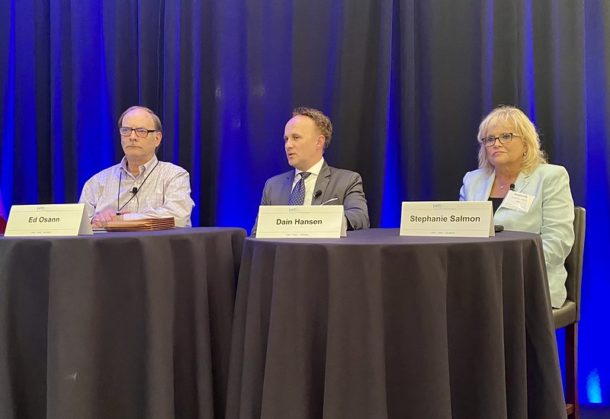
A day 2 panel saw (from l to r) Ed Osann, Senior Water Policy Analyst, NRDC; Dain Hansen, Executive Vice President, Government Relations, IAPMO; and Stephanie Salmon, Washington Representative, PMI, talk about the implications of the Infrastructure Investment and Jobs Act on Drinking Water and Wastewater.
This year’s keynote speakers were Robert Puente, president and CEO of the San Antonio Water System (SAWS), and Don Johnston, senior operations director, Indonesia, for Water.org.
Puente’s presentation looked at three ways in which SAWS, which serves 2 million customers over four counties, uses innovation to deliver water to its customers: advanced metering deployment, “smart” manhole covers, and conservation.
“It’s all about innovation,” he said. “And I think if you talk to our employees, although they will tell you that it’s their idea, we know that they got their idea from coming to events like this. Every good idea, you should expect it to be stolen, to be used by someone else, and you should be flattered by that. I think anything that you look at here started somewhere else, and we went to conferences in other cities and were able to bring back the ideas to SAWS to really get the innovation aspect in this.”
In delivering his keynote address remotely from Jakarta, Indonesia, Johnston spoke about the global water and sanitation crisis’s impact on low-income households — one in nine people lack access to safe water, one in three do not have access to a toilet — and some potential solutions. Working with financial institutions and water utilities, as well as sister company WaterEquity, Water.org helps bring affordable financing to people in need of water.
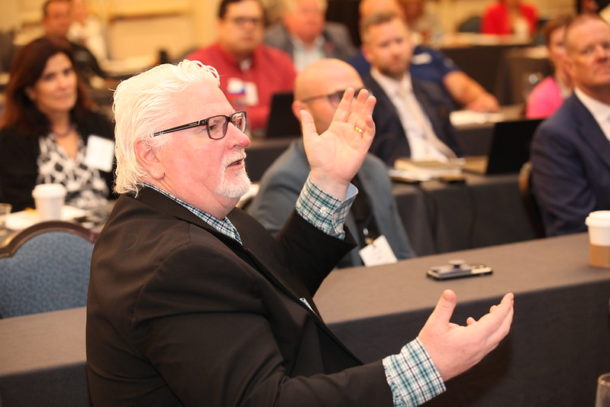
The Hub’s John Mesenbrink asks the hard-hitting questions during the symposium.
“In about 19 years of work on the ground, we’ve seen water and sanitation access reach more than 45 million people through more 10 million microloans disbursed to households with capital of $3.7 billion mobilized,” he said.
In his presentation, Phillip White, manager of plumbing and mechanical inspections for the city of Vancouver, British Columbia, shared how his city addressed the problem of insufficient sewer capacity when it came to capturing large amounts of rainfall through water reuse technologies. One development, the Oakridge Centre, utilized the IAPMO Water Demand Calculator and is expected to have the largest non-potable water system in North America.
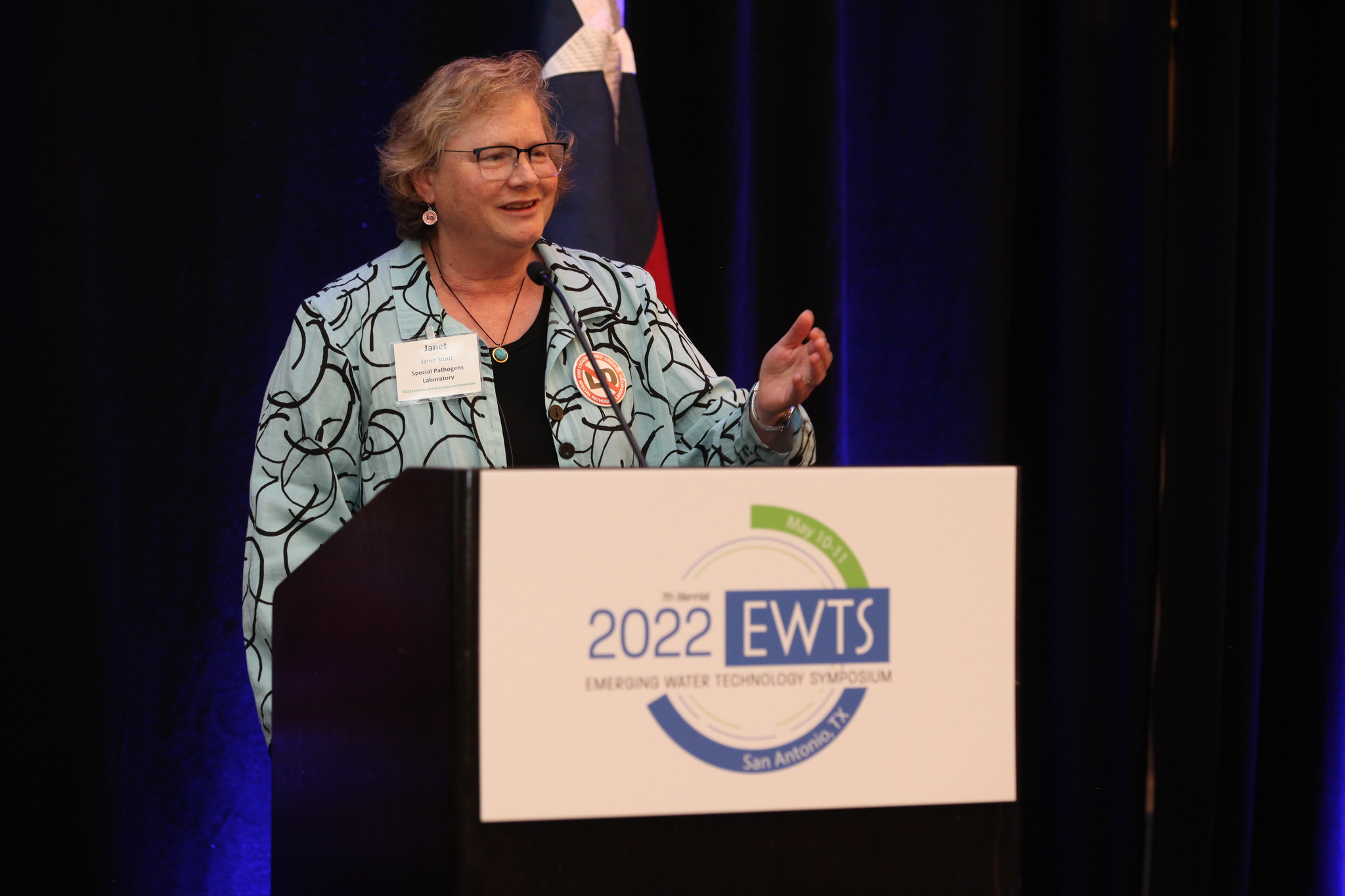
Janet Stout
Another speaker, Special Pathogens Laboratory Executive Vice President/Founder Dr. Janet Stout, looked at approaches and products for mitigating the risk of Legionellosis in point-of-use and point-of-entry building water systems. Improved water management requires knowledgeable Legionella prevention and water service providers, which can come from certification to ASSE/IAPMO/ANSI 12080 for Legionella Water Safety and Management Personnel.
IAPMO will provide sessions from the EWTS on-demand in the near future. To be notified when they are available, register at www.ewts.org/2022-ewts.
Washington, D.C. — The International Association of Plumbing and Mechanical Officials (IAPMO) strongly supports The Healthy Drinking Water Affordability Act, or The Healthy H2O Act, which would provide grants for water testing and treatment technology directly to individuals, nonprofits and local governments in rural communities. Introduced by U.S. Sen. Tammy Baldwin (D-Wisconsin), The Healthy H2O Act would Read more
Washington, D.C. — The International Association of Plumbing and Mechanical Officials (IAPMO) strongly supports The Healthy Drinking Water Affordability Act, or The Healthy H2O Act, which would provide grants for water testing and treatment technology directly to individuals, nonprofits and local governments in rural communities.
Introduced by U.S. Sen. Tammy Baldwin (D-Wisconsin), The Healthy H2O Act would provide grants for water quality testing and the purchase and installation of point-of-use or point-of-entry water quality improvement systems that remove or significantly reduce contaminants from drinking water. The U.S. Department of Agriculture (USDA) would provide the grants directly to individuals and nonprofits or local governments to help people go through the process of water testing and then finding and installing a water treatment product to address their situation.
Communities across the United States face threats to their drinking water from a number of contaminants, including lead, arsenic, nitrates, volatile organic compounds (VOCs), PFOA, PFOS, hexavalent chromium-6, and others. While public water systems monitor for these threats and treat water before it is distributed to points of use, nearly 43 million households primarily in rural communities rely exclusively on groundwater delivered through private wells for their drinking water. This water is not subject to the same regular oversight and testing for contamination, which can delay identification of and response to health threats. The Healthy H2O Act would provide grants for rural communities to increase access to the many technologies for testing and water treatment at the point of use.
Every Wisconsin community deserves access to clean drinking water and an environment free of toxic chemicals. Across our state, communities are struggling to identify and treat known and emerging chemicals that endanger our health, especially for children,” Baldwin said. “My legislation will cut costs and expand access to water testing and treatment for families in rural communities so that when we turn on the faucet, we can be confident our drinking water is safe.”
Through its Community Plumbing Challenges (CPC), IAPMO’s nonprofit organization, the International Water, Sanitation and Hygiene Foundation (IWSH), collaborates with local governments, nonprofit organizations and volunteer tradespeople to identify and address water and sanitation-related issues in rural areas where access to clean, safe water and sanitation is limited or compromised. Baldwin invited IAPMO Director of Workforce Training and Development/IWSH North America Project Manager Randy Lorge, who has been integral to the success of CPCs in South Africa, Indonesia, and the United States, to be her virtual guest for President Biden’s State of the Union address March 2.
“IAPMO believes that everyone should have access to clean water and sanitation. This is why we support the introduction of The Healthy H2O Act and applaud Senator Baldwin for her leadership on this issue,” said Dain Hansen, IAPMO’s executive vice president of Government Relations. “IAPMO has long championed solutions around the globe that lead to lasting quality water and sanitation services. Today, many communities across the United States face challenges with their drinking water — an issue that is only compounded in underserved neighborhoods. Water filtration technologies play an important role meeting those challenges immediately. We recognize this as an essential piece of legislation that helps our country take a critical step in closing the clean drinking water access gap in the U.S.”
The Healthy H2O Act is also supported by The Water Quality Association (WQA), The National Ground Water Association (NGWA), The Water Council, NSF International, American Supply Association (ASA), Water Systems Council, Water Well Trust, and The Groundwater Foundation.
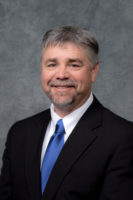
Viega LLC manager Daniel Rademacher has won the PMG Leadership Award from the International Code Council (ICC) for his work in training and educating plumbing professionals around the world. Rademacher, who is the Trades Education Network (VTEN) Program Manager for Viega, was given the award at the ICC’s annual meeting Sept. 18-28 in Pittsburgh, Pa Read more
Viega LLC manager Daniel Rademacher has won the PMG Leadership Award from the International Code Council (ICC) for his work in training and educating plumbing professionals around the world.
Rademacher, who is the Trades Education Network (VTEN) Program Manager for Viega, was given the award at the ICC’s annual meeting Sept. 18-28 in Pittsburgh, Pa. The award is given each year to an individual or organization for exceptional service to the plumbing, mechanical, fuel gas and swimming pool/spa (PMG) industry.
“Dan’s passion for providing relevant and engaging learning opportunities so that plumbing professionals can achieve their career goals, no matter where they are located, is unmatched,” the ICC stated.

“I’m humbled to receive this award from the ICC, an institution which has done so much to advance plumbing and promote the well-being of people around the world,” Rademacher said. “And I’m proud to be able to introduce safe plumbing practices where they are needed most.”
Rademacher directs the Viega Trades Education Network, which partners with trade schools to provide tools, lessons and training to help educate future trades professionals.
This is only the latest industry honor for Rademacher. Last year, he was elected vice president of the board of directors of the American Society of Sanitary Engineering – International. In 2019, he won a World Plumbing Council Education and Training Scholarship to travel to Rwanda for the purpose of developing and contributing further plumbing industry knowledge. Also, he was the International Association of Plumbing and Mechanical Officials (IAPMO) Industry Person of the Year in 2014.
He has 30 years of experience in the industry and is an accomplished instructor. He is certified as a plumbing/mechanical inspector and plans examiner by the IAPMO. He has extensive experience using, implementing and interpreting the Uniform Plumbing Code, the Uniform Mechanical Code, International Plumbing Code, International Mechanical Code and International Fuel Gas Code.
Washington — The IAPMO Group and Plumbing Manufacturers International (PMI) applaud the House Science, Space and Technology Committee for advancing legislation this past week reauthorizing the National Institute of Standards and Technology and calling for the creation of a program for premise plumbing research. During the July 27 committee mark-up of the bill, U.S. Rep Read more
Washington — The IAPMO Group and Plumbing Manufacturers International (PMI) applaud the House Science, Space and Technology Committee for advancing legislation this past week reauthorizing the National Institute of Standards and Technology and calling for the creation of a program for premise plumbing research.
During the July 27 committee mark-up of the bill, U.S. Rep. Paul Tonko (D-N.Y.) was successful in offering an important amendment to H.R. 4609, the National Institute of Standards and Technology for the Future Act of 2021, that would authorize funding at NIST to conduct practical, water-related research on systems within homes and buildings, addressing critical issues such as water quality, efficiency, reuse, sustainability and resilience.
A new program at NIST will help to combat a 900% increase in Legionnaires’ disease since 2000. Legionnaires’ disease is an infection caused by the bacteria Legionella. Symptoms of the disease include fever, cough and pneumonia, while a milder infection can look like a flu-like illness without pneumonia. The sickness can be deadly in older patients or those with other risk factors. Reports of the infection are more common in the summer and early fall when warming, stagnant waters present the best environment for bacterial growth in water systems. News articles from across the country detail the prevalence of this public health challenge.
From the exponential growth of Legionnaires’ disease outbreaks to increasing housing affordability, the industry is waiting and ready to apply the findings of this research to tackle major issues,” said IAPMO CEO Dave Viola. “We applaud Rep. Tonko and other committee members for recognizing this need and including it in this important piece of legislation. This will have a direct, positive impact on America’s homes and buildings today and for the foreseeable future.”
Over the years, IAPMO and PMI have worked with Congress and NIST to address and prioritize research needs on plumbing. Rep. Tonko’s amendment is based on legislation developed by Rep. Matt Cartwright (D-PA) and Sen. Tammy Duckworth (D-IL), who have both previously introduced legislation to expand NIST’s efforts on drinking water. In May 2020, NIST published a report that identified nearly 60 specific research needs and challenges faced by the plumbing industry. This report provides a useful roadmap for addressing those needs through applied research and codes and standards activities.
Kerry Stackpole, PMI CEO, said that “American consumers have the benefit of state-of-the-art water efficient plumbing fittings and fixtures; however, the legacy plumbing that carries water to these fixtures in our homes and offices are based on research and data from the 1930s.” Stackpole noted that “updated research and data by NIST, in conjunction with academia, industry and other key stakeholders, would significantly improve the water efficiency and safety in water systems across the nation.”
Another important issue that will be addressed by NIST research is the sizing of plumbing systems in buildings. Much has changed in the way Americans use water since the 1920s and ’30s when Dr. Roy Hunter, working for the National Bureau of Standards, the predecessor to NIST, developed the method for predicting water use demands in a building and determining how large systems need to be to accommodate those demands. While minor updates have been made over the years to these methods, they are still used today in plumbing codes despite the many improvements and efficiencies made to plumbing fixtures, appliances and other water-using equipment in subsequent years. As a result, it is widely recognized that today’s plumbing systems are often grossly oversized, resulting in increased building costs, wasted water and energy, and declining water quality. The research will seek to resolve this problem and lead to a method for determining plumbing system sizes that are more appropriate for the particular building.
